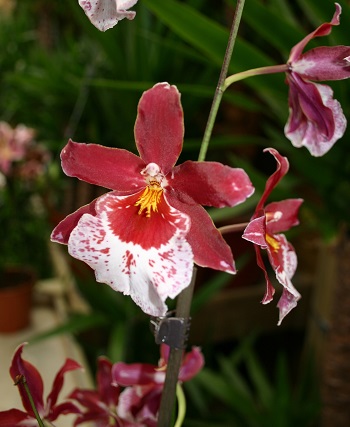The subject of chilling phalaenopsis to induce blooming comes up so often, I’d like to address it with this piece.

First, we need to understand that not all species require it. Interestingly enough, those with white/pink/purple flowers generally do, while those with yellow/orange/red flowers mostly do not. Of course, considering the complex breeding in modern hybrids, that distinction is pretty much “blurred”.
Most of us, as beginners, were led to understand that phalaenopsis “need to have a 10°- to 15°F day/night drop” in order to initiate spiking. Dr. Yin-Tung Wang, while at Texas A&M University, did some research into this area in order to optimize the growing and blooming of these plants. He determined that the day/night differential was not the key, but that an overall average decrease in temperature of the growing conditions led to spiking. More specifically, the plants were shown to require about 10 days to 2 weeks at an average growing temperature of 10°-15° lower than the temperature at which they had been normally growing. In other words, grown at a constant 85°, one could lower the growing area to a constant 70° and initiate spiking, without any day/night variation whatsoever.
Similarly, it can be shown that even with significant day/night temperature variation, spiking will not occur until the average is shifted downward. To test this I used a data recorder to track the daily high and low temperature in my own area. The graph below shows the average daily temperature during 2011.

The blue line represents the average temperature for each date. The red line is a 14 day running average temperature, which is the more important of the two curves. Note that we hit a peak in late-July/early-August of roughly 85°. You’ll also note that in early October, we finally got to an average temperature 15° lower. If Dr. Wang’s explanation of average temperatures was valid, we would expect that our phalaenopsis plants would start spiking approximately 6 to 8 weeks later. That is exactly what happened, and then, as we approached a time frame 6 to 8 weeks later than that, we saw the flower buds reach full development and begin to open.
Before anyone gets concerned about the low averages early and late in the year, let me explain that I control only the minimum temperature with a thermostat, and it is set to 60°, so the greenhouse temperature typically will match the outside temperature during the middle of the year when these various control points were reached.
It is also interesting to note (I won’t bore you with the actual data) that of the 365 measured days, 222 of them actually sustained day/night temperature variations of 15° or more, and they occurred in every month of the year. Never however, did we experience 10 days to two weeks of such daily variation, further supporting that is the average temperatures that are important, and not the day-to-night variation.
Dr. Wang also pointed out that once spike initiation has occurred, the plants will grow their flower spikes best and flower the best if the average temperature is raised back to the elevated level and not kept at a low level.
Ray Barkalow has been growing orchids for over 45 years, and owns First Rays, which offers horticultural products to the hobby grower. You can visit his website at FirstRays.com.
Related Articles & Free Email Newsletter Sign Up
How to Achieve Proper Air Management in Orchid Culture
How to Prepare Semi-Hydroponics Media for Use with Orchids
How to Use the Sphag-n-Bag Recovery Method for Damaged Orchids


Comment here